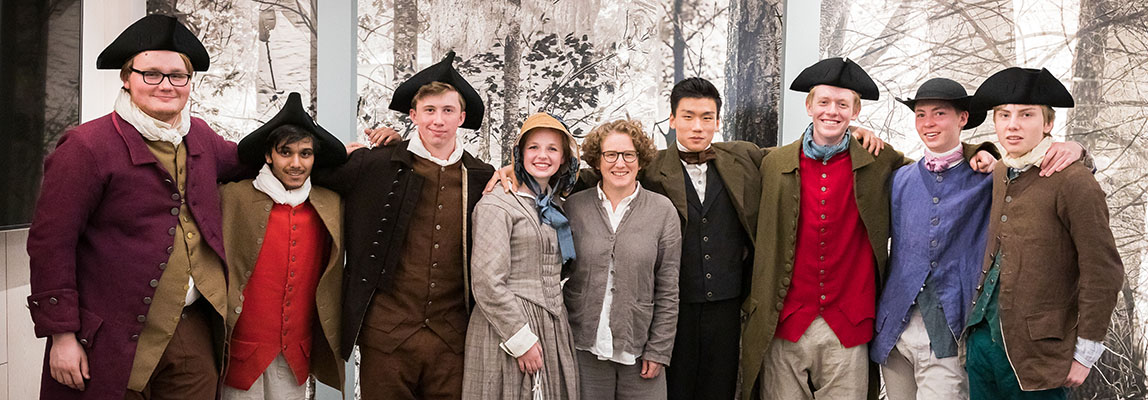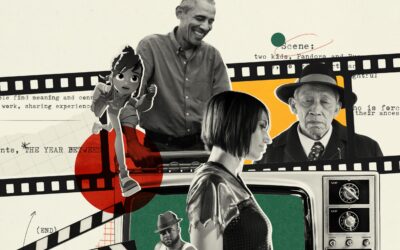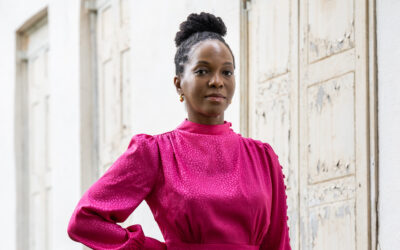
CA history teacher Kim Frederick (center) with the students in her History of Concord class following their gallery talks at the Concord Museum.
The statue by Daniel Chester French erected at Concord’s Old North Bridge in 1875 depicts a farmer abandoning his plow to take up arms in the American War of Independence. Inscribed on the sculpture’s base, the first stanza of Ralph Waldo Emerson’s “Concord Hymn” also commemorates the “embattled farmers” who fired that “shot heard round the world.” Farmers they may have been, but the notion of the local militia as militarily unsophisticated needs reexamining, according to Concord Academy students.
On May 9 at the Concord Museum, eight classmates from CA’s U.S. history course Object Permanence: Concord and the American Nation gave public gallery talks in the new Anna and Neil Rasmussen Education Center. Hank Parker ’20 demonstrated historical inaccuracies in the statue, created a century after the Battle of Lexington and Concord — the Minuteman’s powder horn, for example, is held on the wrong side. Wearing tricorn hats and clothing authentic to the period, Hank and Lucian Sharpe ’20 described the coordinated, risky maneuvers that Patriots engaged in to smuggle four British canons from within the enemy encampment on the Boston Common long before the morning of April 19, 1775. “An incredible spy network kept them safe,” Lucian explained. “These weren’t farmers fresh off the fields. Concordians had weapons concealed, and they were ready to follow orders.” The lesson for museum visitors: The British attack was no surprise; it wasn’t luck that allowed the colonists to force a British retreat but rather how prepared they were for battle.
What better place to study history than in Concord, the birthplace of the nation and the epicenter of transcendentalism and America’s literary renaissance? And what better way to engage with history’s living presence than by learning from actual objects from the past?


Hank Parker ’20 and Lucian Sharpe ’20 delving into military history in their Revolutionary War gallery talk.
Guided by Concord Museum curator David Wood and Susan Foster Jones, manager of school partnerships, CA students had the extraordinary opportunity to fully access one of the oldest and most treasured collections of Americana in the United States. The students learned how to approach the history of Concord through its objects, from household goods of its earliest European settlers to weapons from the Revolution and artifacts from Emerson, Henry David Thoreau, and the Alcott family.
“These students are so lucky they don’t actually quite even know it,” said CA history teacher Kim Frederick at the public event that culminated the semester’s work. She noted that the course had been years in the making and had been possible only with the dedicated partnership of the Concord Museum and significant help from the Minuteman National Historical Park.
In preparation for the real-world stakes of representing both their school and the Concord Museum at a public event, the class spoke with professionals at several museums about how exhibitions are assembled. At Boston’s Museum of Fine Arts, they examined the Revolutionary collection and learned about how to organize an exhibition and write object labels. At the Boston Children’s Museum, they toured the Native American object archives and considered how to tell compelling stories without written descriptions.
The students read extensively about various periods in local history. Beginning with one of their first class meetings, they gained experience with object comparison and visual thinking strategies, presented at one point with a painting of a boy and his family from which to make inferences and at another, with a snowshoe that turned out to be Thoreau’s. “We had so much fun doing that,” says Erik Bjork ’ 20. “We noticed so much. It really prefaced the rest of the semester.”


Left: The gallery talk by Chirag Aggarwal ’20 and Connor Dayton ’20 focused on the lives of former slaves who lived in Concord. Right: Kate Bacigalupo ’20 and Steven Xu ’20 spoke about Henry David Thoreau’s evolution from a promoter of pacifism to a militant abolitionist.
For Frederick, access to real artifacts is of vital importance. “We spent a lot of time talking about ways to tell stories with objects,” she says. “I want students to own and author the content.”
“Kim’s classes are very engaging,” Lucian says. “They’re about getting out and learning for yourself. You gain thoroughness and depth. You take a more careful look at something if you’re not just told about it.”
The students practiced distilling complex summaries of 500 words down to 50. (“Writing labels is insanely hard,” says Frederick.) They worked on gallery chats about one or two objects, then selected topics for their final presentations, with feedback at every stage of development and rehearsal from the museum staff.
For the gallery talks on May 9, Frederick had baked a cake following the historical recipe of Mary Merrick Brooks, a Concord abolitionist, who sold the cakes to support the antislavery paper The Liberator. The cake made an appearance in the presentation by Steven Xu ’20 and Kate Bacigalupo ’20, who told about Thoreau’s transformation, over the span of just 11 years, from the pacifist author of Civil Disobedience to militant abolitionist, largely due to the influence of his sisters and the women in their activist circles.


Ryan Mach ’20 and Erik Bjork ’20 giving a gallery talk about the intermingling of native and English cultures in early America.
Each of the four gallery talks delved into a particular era in Concord’s influential past. Within just seven minutes, CA students questioned common assumptions about the country’s founding and history, often using objects from the museum’s holdings, selected especially for the event, to enhance the collections on display.
Erik and Ryan Mach ’20 chose to add two arrowheads — both of native construction, one made of stone and another, adapted from English technology, of stone and steel — to the Colonial gallery. They considered the complexities of the intersections of these two cultures, and how through an altogether different relationship to the land, the English exacerbated longstanding grievances among native nations, propelling all parties into the conflict that became King Philip’s War.
Conner Dayton ’20 and Chirag Aggarwal ’20 made use of the museum’s collection of objects that had belonged to Thomas Dugan, a former slave in Virginia who lived as a free black man after coming to Concord in 1791. To his story, they contrasted two paintings, aristocratic hunting scenes once owned by a Concord slaveholder, Colonel John Cuming. Unlike Cuming’s, Dugan’s gun, they suggested, would not have been used just for sport but primarily for self-defense.
Addressing guests on May 9, Suzi Fonda, Concord Museums’s director of education and public programs, called the semester of work that led up to CA students’ gallery talks the most in-depth partnership yet between the two institutions.

For the gallery talks, CA history teacher Kim Frederick baked this Brooks cake from abolitionist Mary Merrick Brooks’ 19th-century recipe.
This work has built upon earlier collaborations and the passions of the museum staff and CA’s history teachers for helping students conduct historical research using primary sources and actual historical objects. Frederick first reached out to the Concord Museum staff several years ago when she was revamping her Making of the Muslim World class, and they collaborated on an entire unit of object study.
In 2018, students in Topi Dasgupta’s History Design Studio: Digital History course created online companion experiences for the Concord Museum’s website to extend a major exhibition on Henry David Thoreau. The same year, the Concord Museum also provided objects for 3D scanning for a CA collaboration with the Robbins House, Concord’s African American history museum, as part of an interdisciplinary course co-taught by Frederick and CA film teacher Justin Bull.
This hands-on approach has solidified a love of history for several CA students. Erik, along with his brother Tim Sandin ’22, interned with the National Parks Service at the historical home of authors, The Wayside, last summer. And at the gallery talk on May 9, Kate, who showed visitors Helen Thoreau’s songbook while discussing her influence on her brother’s views on abolition, with her practiced delivery in a bonnet appropriate to the 19th-century, looked as though she couldn’t wait to begin an internship she has planned with the Concord Museum next fall.
Related Story
In a polarized America, museums inspire an exceptional level of public trust across the political spectrum. What responsibilities and opportunities do they have in return? Read more from members of the CA community about the important roles these institutions are playing in our society in our CA Magazine feature story “America’s Neutral Ground?”


